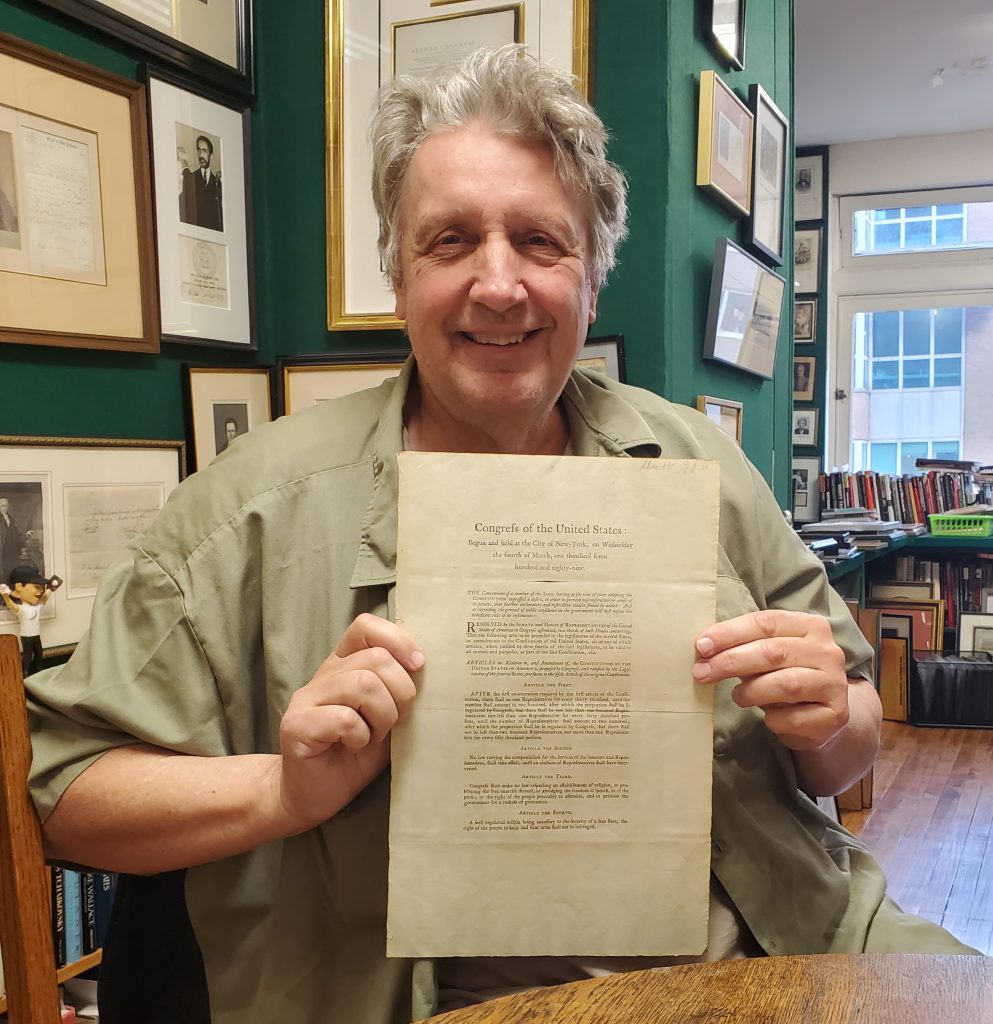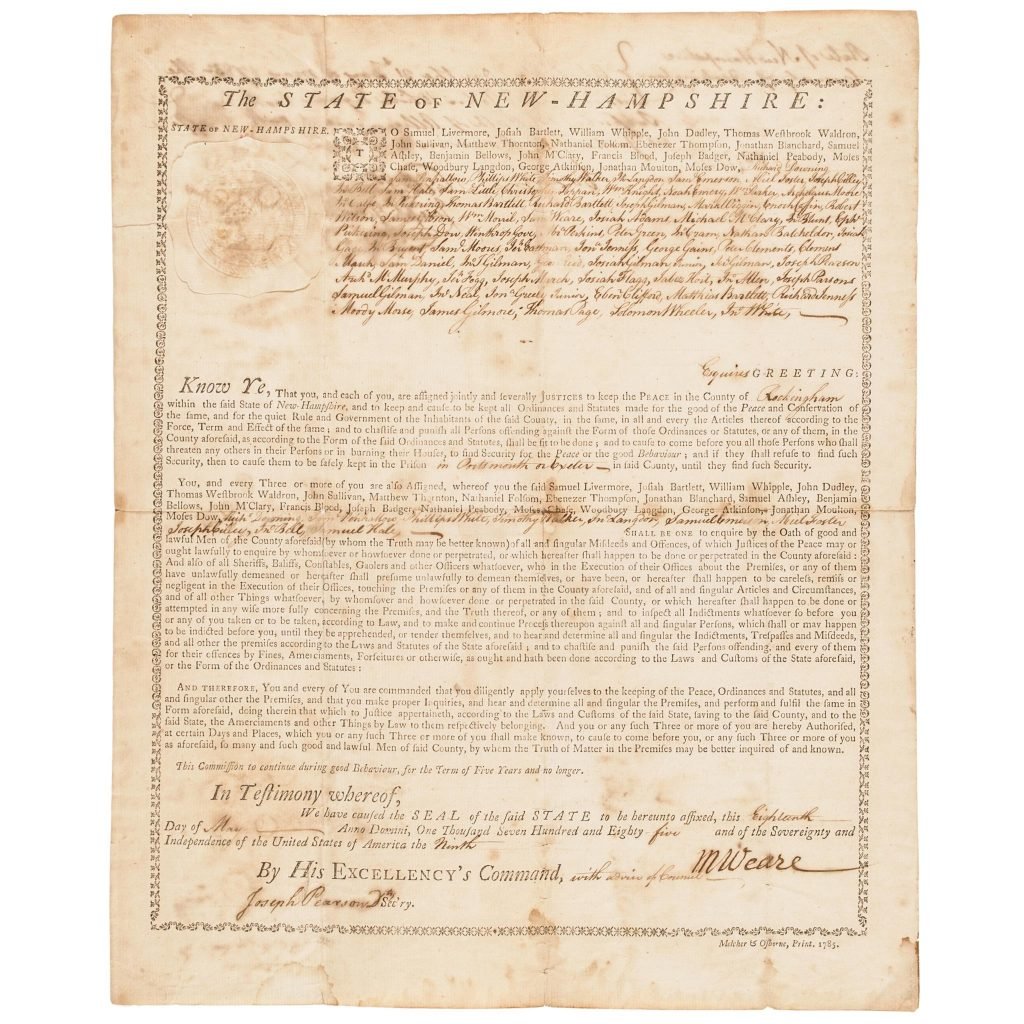Law & Politics
Rare Historic Document Mysteriously Arrives at a Republican Party Office
A 1785 document arrived unbidden in the mail.

A 1785 document arrived unbidden in the mail.

Sarah Cascone

When a mysterious package arrived at the offices of the New Hampshire Republican Party back in January, party leaders were shocked to discover inside the “Oath of Allegiance,” an obscure piece of state history, donated out of the blue by a New Orleans collector.
The rare 1785 document was written by Meshech Weare, the first president of New Hampshire, and signed by a number of state leaders promising to “keep the peace.” The oath reflects the uncertainty of our nation’s early years, between the signing of the Declaration of Independence in 1776 and the adoption of the Constitution in 1789.
At a time when the newly forged union was still all-too-fragile, the oath represented New Hampshire’s leaders’ allegiance to the fledgling republic.
Stanley Klos, a historic preservationist specializing in Early American documents, had purchased the oath at Virginia’s Early American History Auctions for just $480 in 2022.
.@NHGOPChairman presenting a 1785 “Oath of Allegiance” issued by Meshech Weare, first president of New Hampshire, to @NHSecretary.
The document will now live with other historical articles at the State Archives. pic.twitter.com/DvZs69zSrn
— New Hampshire Republican Party (@NHGOP) September 4, 2024
“I expected it to go for 10 times that value, but people just didn’t know what it was,” Klos told me. “New Hampshire was the first state to have a constitution, and it was also the first state to vote for the Declaration of Independence. People don’t realize that!”
Klos is deeply passionate about collecting written pieces of the past, and about pairing documents that might otherwise be forgotten with people who will connect with them. (I know this personally because—full disclosure—Klos is my husband’s uncle, and gives incredibly thoughtful documents as gifts for weddings and other life milestones.)
The Oath of Allegiance “is probably worth easily double what it originally had sold for, and perhaps more in today’s market,” Early American History Auctions president Dana Linett told me, noting that interest in colonial and Early American documents is on the rise as the 250th anniversary of the birth of the United States approaches in 2026.
The document sold in 2022 for less than its presale estimate of $600 to $800. The relatively affordable price point is actually reflective of much of the market for printed or handwritten historic documents from the U.S. that predate the War of 1812.
“There’s a wide array of value depending upon their importance and who signs them and the condition of each of the documents,” Linett said. ”The signatures are extraordinarily important, whether it’s signed by George Washington or John Hancock or Meshech Weare, who is lesser known, but still very important in the state of New Hampshire during that period of time.”
“We have a large collection of [Weare’s] papers here at the archives,” New Hampshire State Archivist Ashley Miller told me. “He corresponded with George Washington, was on the Committee of Safety, and heavily involved in the war efforts during the Revolution.”
It was the signature of Weare, known as the “father of New Hampshire,” that initially piqued Klos’s interest in the Oath of Allegiance.
“My wife found Meshech Weare’s actual copy of the Journals of the Continental Congress for 1776, which include the Declaration of Independence and bought it for me as a gift,” he said, “So I was always looking for his documents.”
Klos was inspired to pass the 16-by-13-inch document along to New Hampshire Republicans on the occasion of the presidential primary.
Klos is a proponent of expanding the House of Representatives, which he believes is more in line with the vision of our Founding Fathers, while also helping solve the issues of the Electoral College imbalance and gerrymandering. By gifting the letter ahead of the primary, he hoped to call attention to New Hampshire’s 400-member house as a model for how increased representation can work.
“There were originally 12 articles in the Bill of Rights, and article the first would have capped congressional districts at 50,000 [per representative],” Klos said. “It didn’t get ratified because they made a clerical error.… which made it nonsense.”

The 1785 New Hampshire Oath of Allegiance, signed by the state’s first president, Meshech Weare. Photo courtesy of Early American History Auctions.
Klos is still hoping that he can foment a movement to expand the House of Representatives. But though his out-of-the-blue donation didn’t spark the action he was hoping for, it was certainly appreciated by its recipients.
At first, New Hampshire Republican Party Chairman Chris Ager was worried the letter was hate mail, or a death threat.
“The postmark was from New Orleans,” he told the Concord Monitor, which first reported the unexpected gift. “I’m like, ‘There’s a lot of crazy people down there.’”
But Ager took the document to the state archives, where Miller was able to confirm its authenticity and historical significance.
“I’m always so awestruck whenever I come across a new piece of history,” she told me. “That’s the beauty of archives—folks are constantly discovering new materials in the places you’d least expect to find them—basements, attics, yard sales, etc.
Miller also worked to get a new law passed to allow the state archives to accept the piece as a donation.
The legislation went into effect in July, and the state Division of Archives and Records Management held a formal ceremony accessioning the oath last Wednesday.
“I’m thrilled whenever one of our customers feels that dedication to put the any document back with the public, where it belongs,” Linett said.
Klos never heard back from the New Hampshire Republicans and was unaware that his donation had made its way to the state archives until the Monitor reached out for a quote.
“I’m glad it is where it is with the New Hampshire archives, because it is a remarkable document,” he said.
The oath is what collectors call a partially printed document—essentially a printed form that would be filled out to complete it. That means this is a unique piece.
It has the paper and wax official embossed Seal of the State of New Hampshire on its top left corner. There is a large, three-inch signature from Weare, who served as the state’s president (the office now known as governor) from 1794 to 1785. The other signatories include Josiah Bartlett, the second signatory of the Declaration of Independence.
“It has some real sizzle to it,” Klos said. “Very large with the big seal, very ornate—suitable for framing. It’s just a beautiful, beautiful document.”